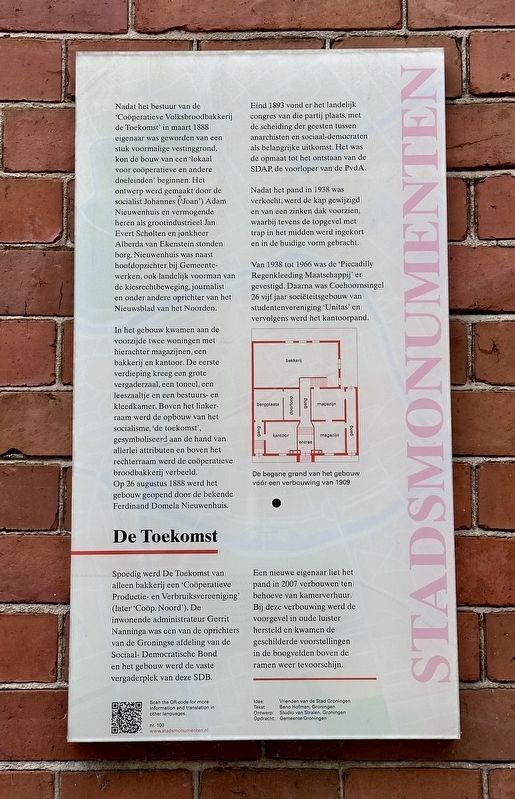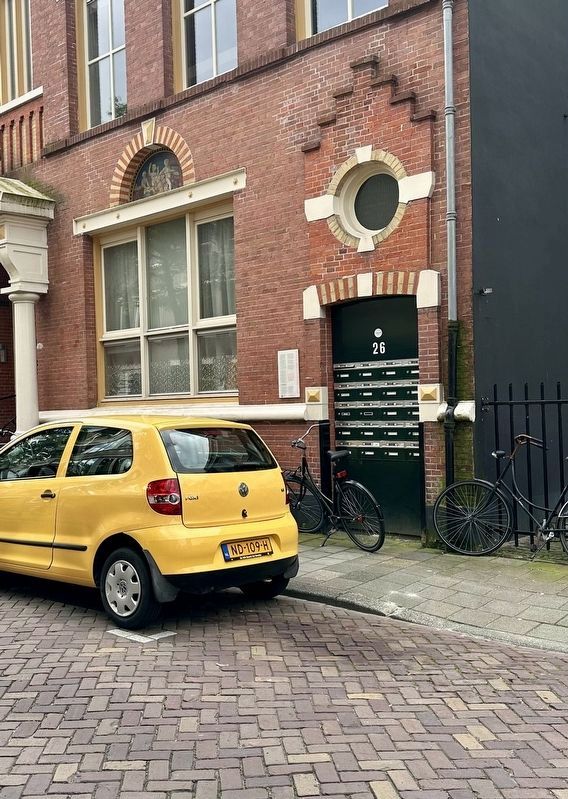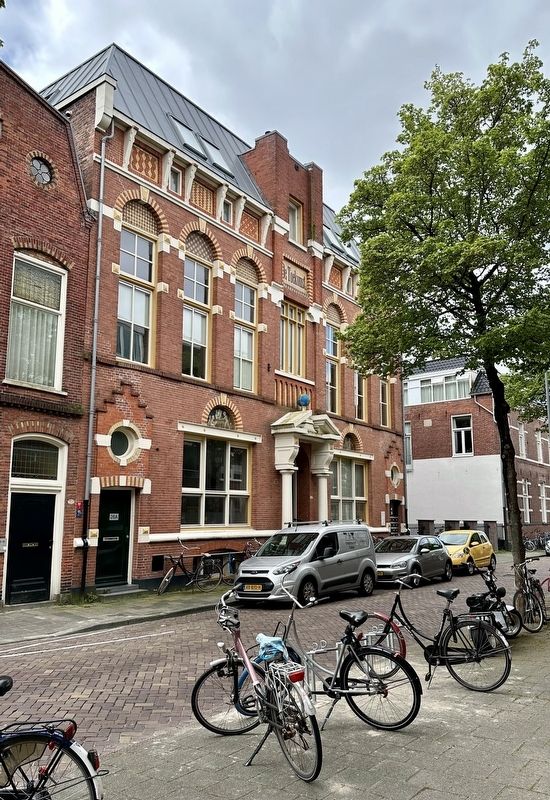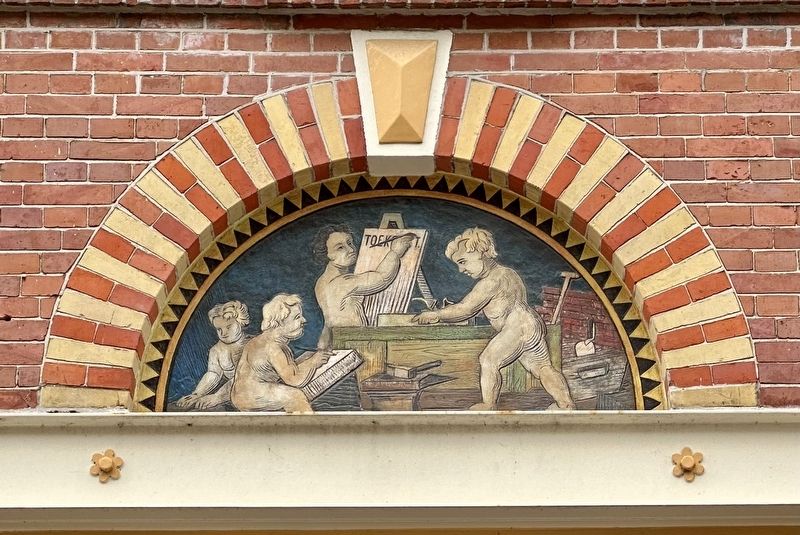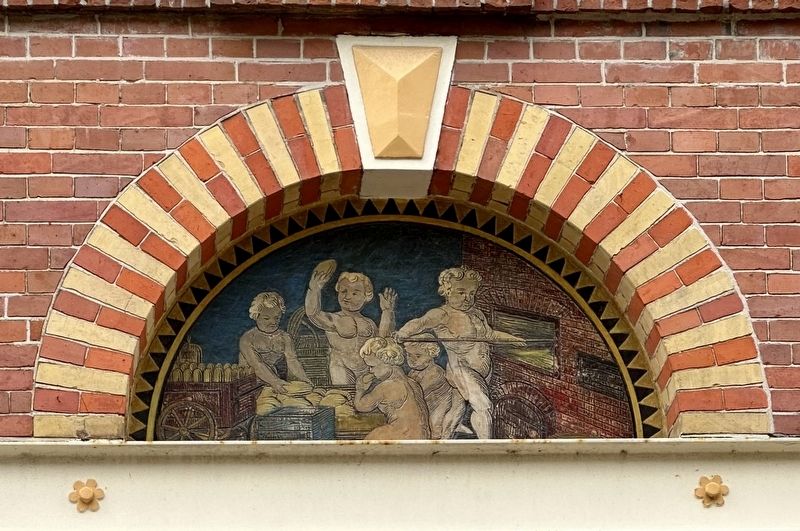Groningen, Netherlands — Northwestern Europe
De Toekomst / “The Future”
— Stadsmonumenten —
In het gebouw kwamen aan de voorzijde twee woningen met hierachter magazijnen, een bakkerij en kantoor. De eerste verdieping kreeg een grote vergaderzaal, een toneel, een leeszaaltje en een bestuurs- en kleedkamer. Boven het linkerraam werd de opbouw van het socialisme, ‘de toekomst’, gesymboliseerd aan de hand van allerlei attributen en boven het rechterraam werd de coöperatieve broodbakkerij verbeeld. Op 26 augustus 1888 werd het gebouw geopend door de bekende Ferdinand Domela Nieuwenhuis.
Spoedig werd De Toekomst van alleen bakkerij een ‘Coöperatieve Productie- en Verbruiksvereeniging’ (later ‘Coöp. Noord’). De inwonende administrateur Gerrit Nanninga was een van de oprichters van de Groningse afdeling van de Sociaal- Democratische Bond en het gebouw werd de vaste vergaderplek van deze SDB.
Eind 1893 vond er het landelijk congres van die partij plaats, met de scheiding der geesten tussen anarchisten en sociaal-democraten als belangrijke uitkomst. Het was de opmaat tot het ontstaan van de SDAP, de voorloper van de PvdA.
Nadat het pand in 1938 was verkocht, werd de kap gewijzigd en van een zinken dak voorzien, waarbij tevens de topgevel met trap in het midden werd ingekort en in de huidige vorm gebracht.
Van 1938 tot 1966 was de ‘Piccadilly Regenkleeding Maatschappij’ er gevestigd. Daarna was Coehoornsingel 26 vijf jaar sociëteitsgebouw van studentenvereniging ‘Unitas’ en vervolgens werd het kantoorpand.
Een nieuwe eigenaar liet het pand in 2007 verbouwen ten behoeve van kamerverhuur. Bij deze verbouwing werd de voorgevel in oude luister hersteld en kwamen de geschilderde voorstellingen in de boogvelden boven de ramen weer tevoorschijn.
(English translation provided by Stadsmonumenten.nl)
After the Board of the "People's Cooperative Bakery of the Future” in March 1888 had become the owner of a piece of former fortress land, construction of a “Room for cooperative and other purposes” could start. The design was made by the socialist John (Joan) Adam Nieuwenhuis and wealthy men like industrialist Jan Evert Scholten and jonkheer Alberda of Ekenstein were the guarantor. Nieuwenhuis was next to superintendent at Public Works, also a national leader of the suffrage movement, journalist and among other things founder of the Newspaper of “The North”.
On the front side of the building two houses were built and behind the two houses were warehouses, a bakery, and an office. At the first floor a large meeting room, a theatre, a reading room and a board and dressing room were created. Above the window on the left, the upcoming of Socialism, " the future", was symbolized by various attributes and at the upper right window, the cooperative bakery was represented. The building was opened by the famous Ferdinand Domela Nieuwenhuis On August 26 in 1888.
Soon the Future bakery became a “Cooperative Production and Consumption Society” (later “Coop. North”). The resident manager Gerrit Nanninga was a founding member of the Groningen branch of the Social Democratic Bond and the building was a regular meeting place of the SDB.
At the end of 1893, the national congress of the party took place in the same building, with the separation of spirits between anarchists and social democrats as an important outcome. It was the prelude to the creation of the SDAP, the precursor of PvdA.
After the property was sold in 1938, the cap was changed and a tin roof was placed, at the same time the gable, with stairs in the middle, was shortened and made into its current shape.
From 1938 to 1966 the “Piccadilly Rain Clothing Society” was located there. After that Coehoornsingel 26 was the clubhouse of student society “Unitas” for five years and became an office building later.
A new owner renovated the building in 2007 to make it ready for room rental. With this renovation, the facade was restored to its former glory and painted illustrations in the tympanums above the windows reappeared.
Erected by Gemeente Groningen. (Marker Number 100.)
Topics and series. This historical marker is listed in these topic lists: Government & Politics • Industry & Commerce • Labor Unions. In addition, it is included in the Groningen Stadsmonumenten series list. A significant historical date for this entry is August 26, 1888.
Location. 53° 12.814′ N, 6° 33.97′ E. Marker is in Groningen. Marker is on Coehoornsingel, on the right when traveling east. Touch for map. Marker is at or near this postal address: Coehoornsingel 26, Groningen 9711 BD, Netherlands. Touch for directions.
Other nearby markers. At least 8 other markers are within walking distance of this marker. Ged. Zuiderdiep 96-98 (about 90 meters away, measured in a direct line); Synagogue (about 150 meters away); Hereplein 4-5 (about 180 meters away); Herestraat 106 (about 210 meters away); Hoofdstation / Main Railway Station (approx. 0.3 kilometers away); Sociaal Democratische Bond / Social Democratic Union (approx. 0.4 kilometers away); Vismarkt 56 (approx. 0.4 kilometers away); Vereeniging van Groningen Handelaren / Groningen Merchants Association (1847 - 1992) (approx. 0.4 kilometers away). Touch for a list and map of all markers in Groningen.
Also see . . . De Toekomst’ Groningen 1888 -1938 (VHV).
Excerpt (in translation): In July 1888, De Toekomst was the first cooperative in the Netherlands. The building consisted of two houses, each with two rooms, one of which was a basement room. Behind this warehouses and the bakery, as well as an office. On the first floor there was a large meeting room of 160 m2, a reading room, a stage and boardroom and dressing room. The bakery had a spacious workshop for those days, the best in the city of Groningen.(Submitted on May 28, 2023.)
Credits. This page was last revised on December 31, 2023. It was originally submitted on May 28, 2023, by Andrew Ruppenstein of Lamorinda, California. This page has been viewed 44 times since then and 6 times this year. Photos: 1, 2, 3, 4, 5. submitted on May 28, 2023, by Andrew Ruppenstein of Lamorinda, California.
